🔧 AC Freezing Up? Complete Guide to Fix Ice Buildup on Coils & Pipes
Problem Overview
Your AC is running but covered in ice—frozen evaporator coils, iced copper pipes, or frost on the indoor unit. This freezing prevents cooling, causes water leakage, and can damage the compressor. Ice buildup has specific causes: restricted airflow from dirty filters, low refrigerant levels, thermostat issues, fan motor problems, or blocked return air. This guide helps you safely defrost and fix the root cause.
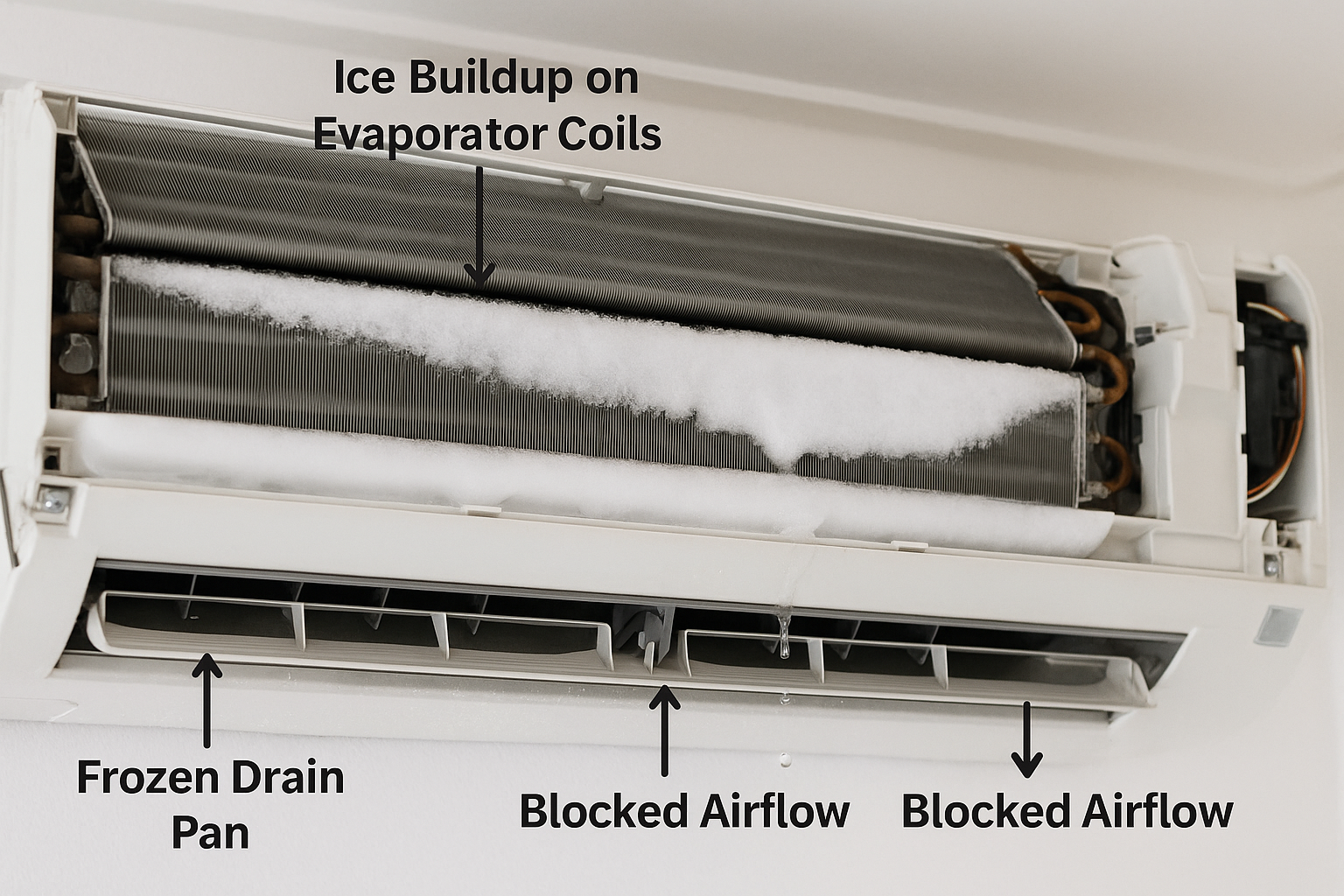
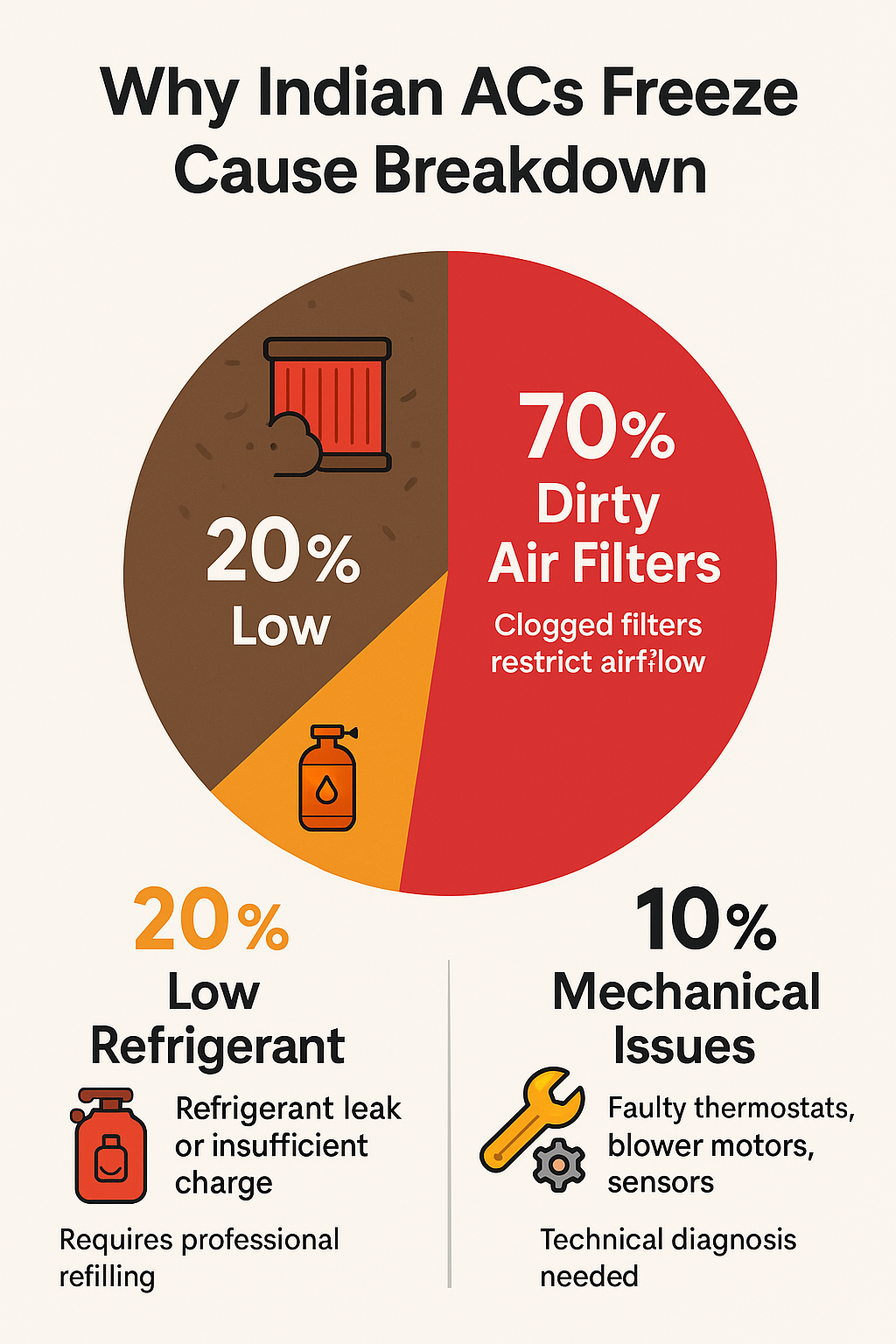
🇮🇳 Indian Climate Context: Peak AC Freezing Season
April-June (Summer Peak): AC freezing issues spike during India's hottest months when ACs run continuously for 8-12 hours daily. Small bedrooms in Delhi NCR, Pune, Bangalore commonly experience overnight freezing when set at extreme low temperatures (16-18°C) in tightly sealed rooms.
Dust & Hard Water Impact: Delhi NCR and Pune experience heavy dust accumulation on filters—clean every week during April-June. Hard water areas (Bangalore, Gurgaon, Noida) see faster coil fouling requiring professional cleaning twice yearly.
Power Fluctuation Considerations: Voltage instability in tier-2 cities can weaken blower fan motors over time, reducing airflow and causing freezing. Use stabilizer to protect fan motor and prevent gradual performance decline leading to ice buildup.
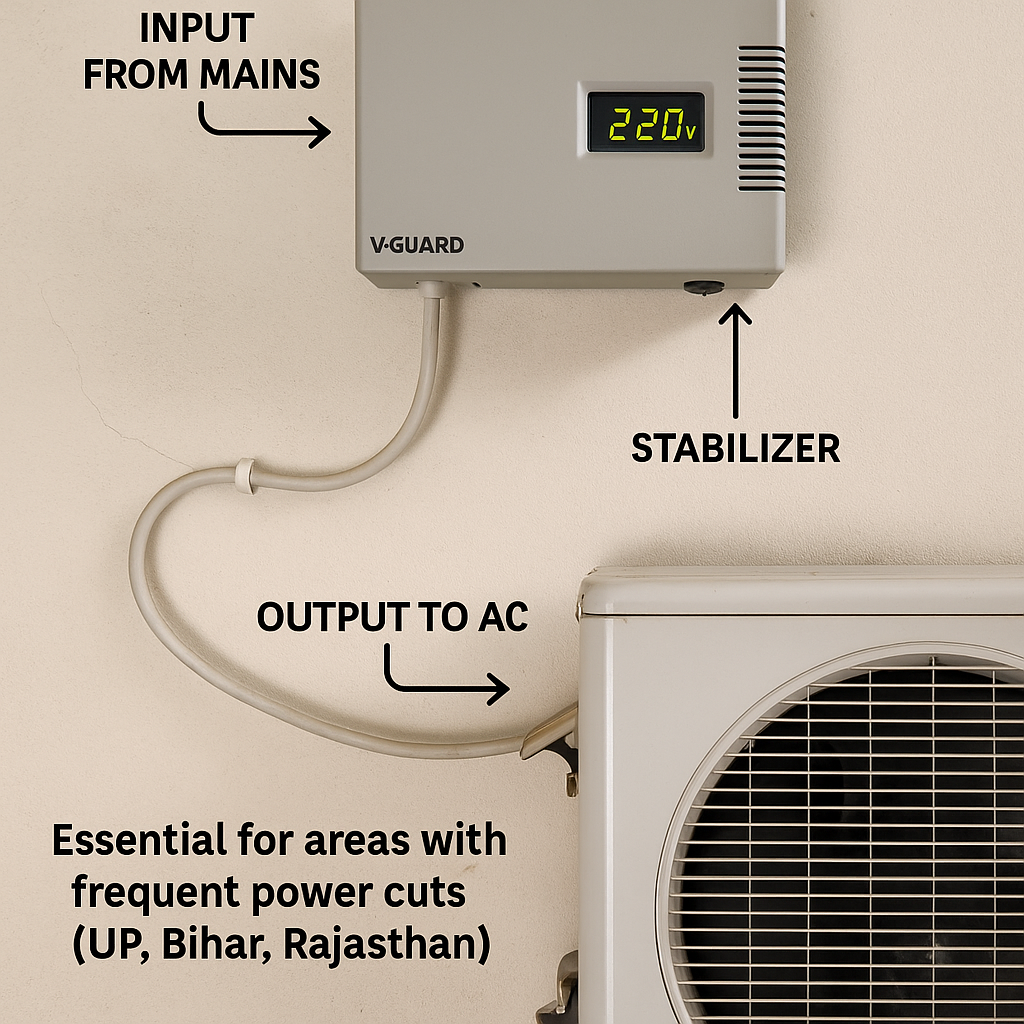
📑 Table of Contents
Safety First
-
!
Turn off AC immediately: Running AC with frozen coils damages compressor due to liquid refrigerant return. Switch off at circuit breaker and allow complete defrosting before any troubleshooting.
-
!
Never chip or scrape ice: Evaporator fins are extremely delicate—chipping ice will permanently damage coils requiring expensive replacement (₹5,000-₹15,000). Let ice melt naturally.
-
!
Water damage prevention: Ice melting creates significant water flow. Place large towels, containers under indoor unit. Monitor drain pan—may overflow if drain pipe blocked.
-
!
Electrical hazard during defrost: Keep power OFF during entire defrosting process. Water and electricity are deadly combination. Only restore power when unit completely dry.
-
!
Refrigerant work restricted: If ice caused by low refrigerant, professional technician required. Never attempt refrigerant work yourself—requires certification and specialized equipment.
🔍 Quick Checks ⏱️ 2-3 minutes
1 Locate Ice Formation
Open indoor unit cover and check evaporator coils behind filter. Ice can form on coils, copper refrigerant pipes, drain pan. Note exact location of freezing.
2 Check Air Filters
Remove filters—if heavily clogged with dust, this is likely culprit. Blocked filters restrict airflow causing coil temperature to drop below freezing point. Learn proper air filter cleaning techniques.
3 Inspect Return Air Vents
Check if furniture, curtains, or objects blocking return air grilles. AC needs proper air circulation—blockages cause freezing.
4 Listen to Blower Fan
Was blower fan running at normal speed before freezing? Weak or slow fan reduces airflow over coils causing ice formation.
5 Check Temperature Setting
Running AC at very low temperature (16-18°C) for extended periods in well-sealed rooms can cause freezing. Especially common in small rooms at night.
6 Look for Refrigerant Signs
Oil stains on copper pipes, ice on outdoor unit, or AC that cooled poorly before freezing indicate possible low refrigerant issue.
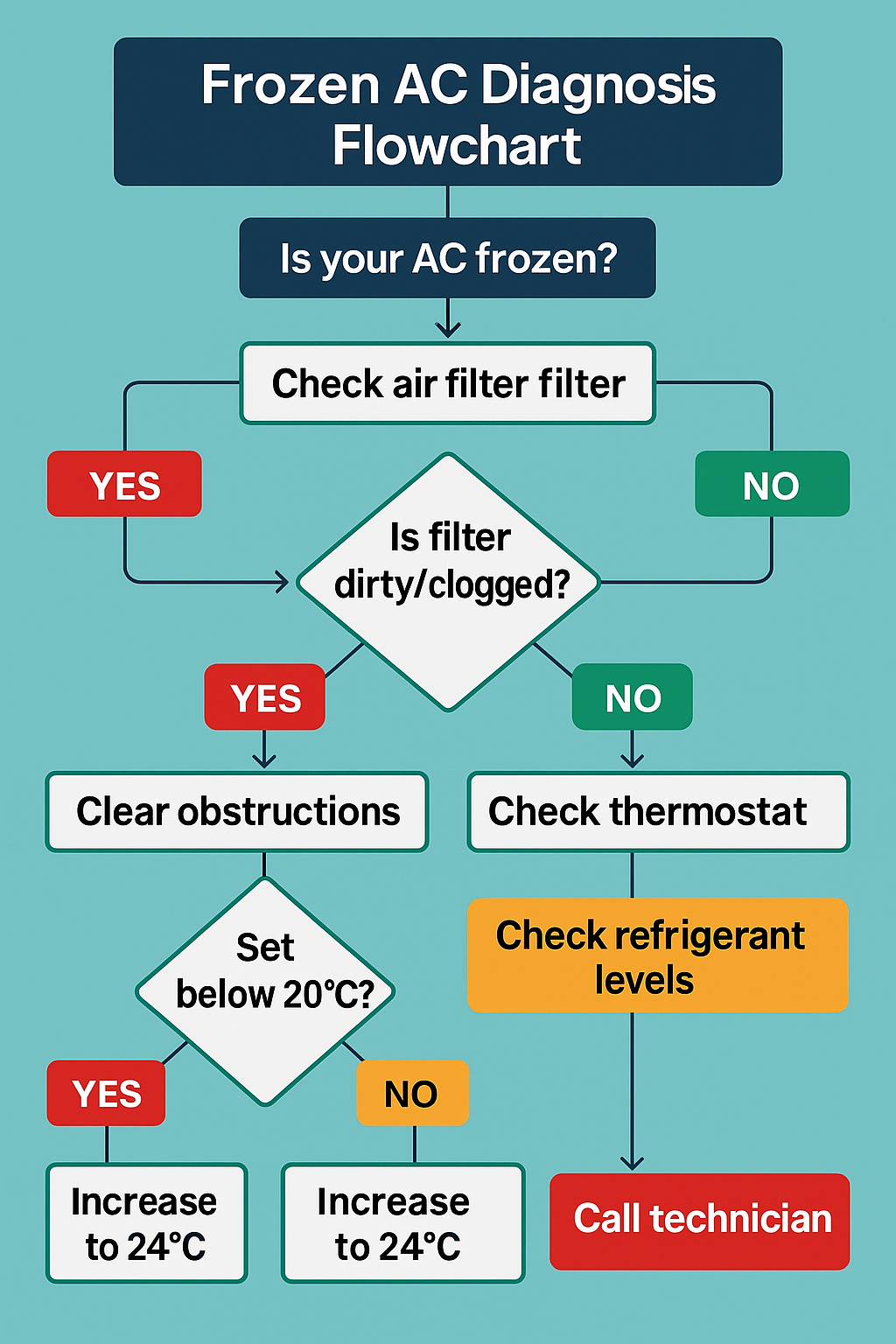
💡 Common Causes → Solutions
Problem
Dirty/clogged air filters severely restricting airflow (70% of freezing cases)
Solution
Defrost AC completely (2-4 hours). Clean filters thoroughly with water and detergent, dry fully. Clean every 2 weeks to prevent recurrence. Instant prevention. See our detailed filter cleaning guide.
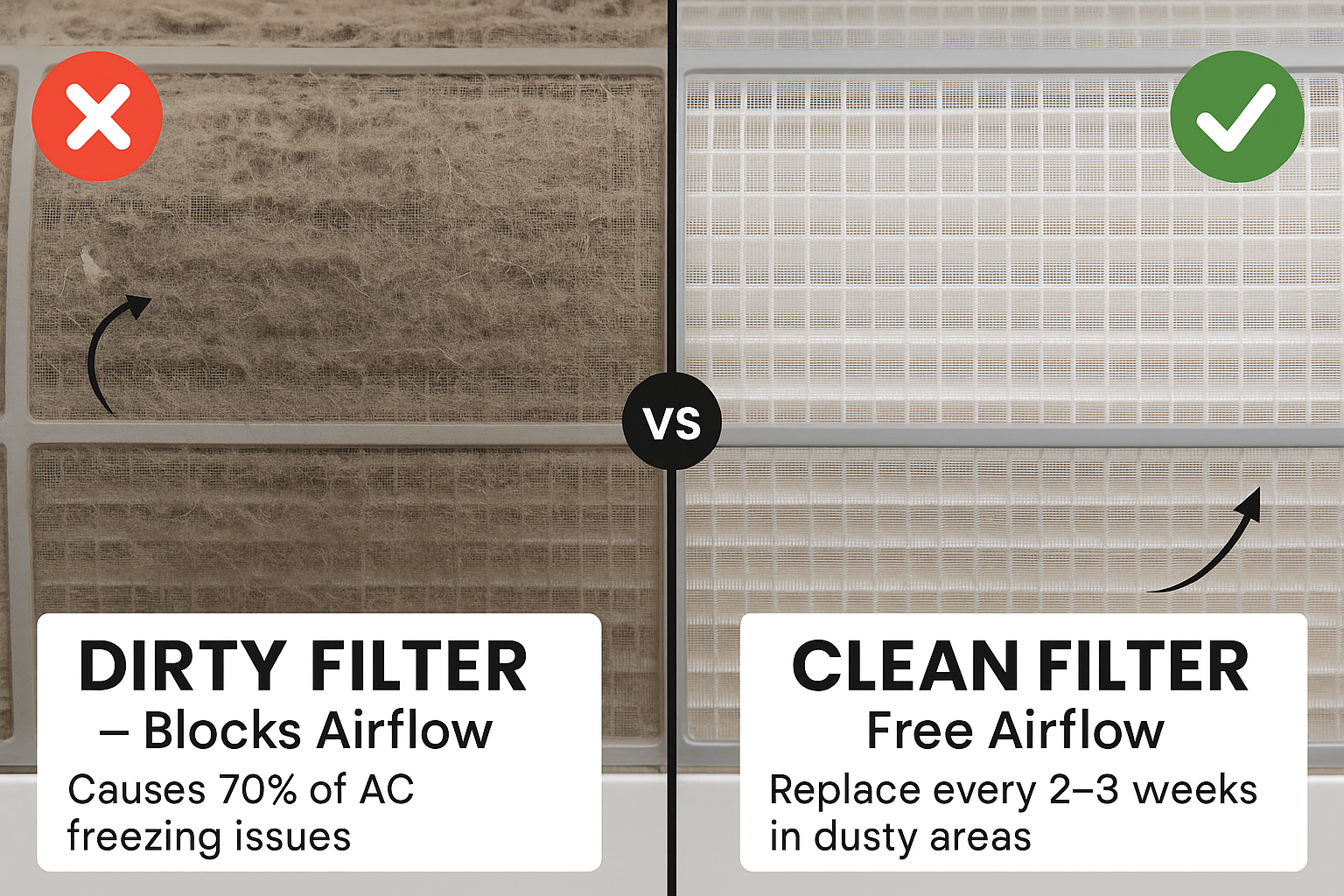
Problem
Low refrigerant charge causing excessive cooling at evaporator coil
Solution
Professional technician required for leak detection, repair, vacuum, and proper gas refill. Cost: ₹2,500-₹6,000. Never DIY refrigerant work—requires certification and equipment.
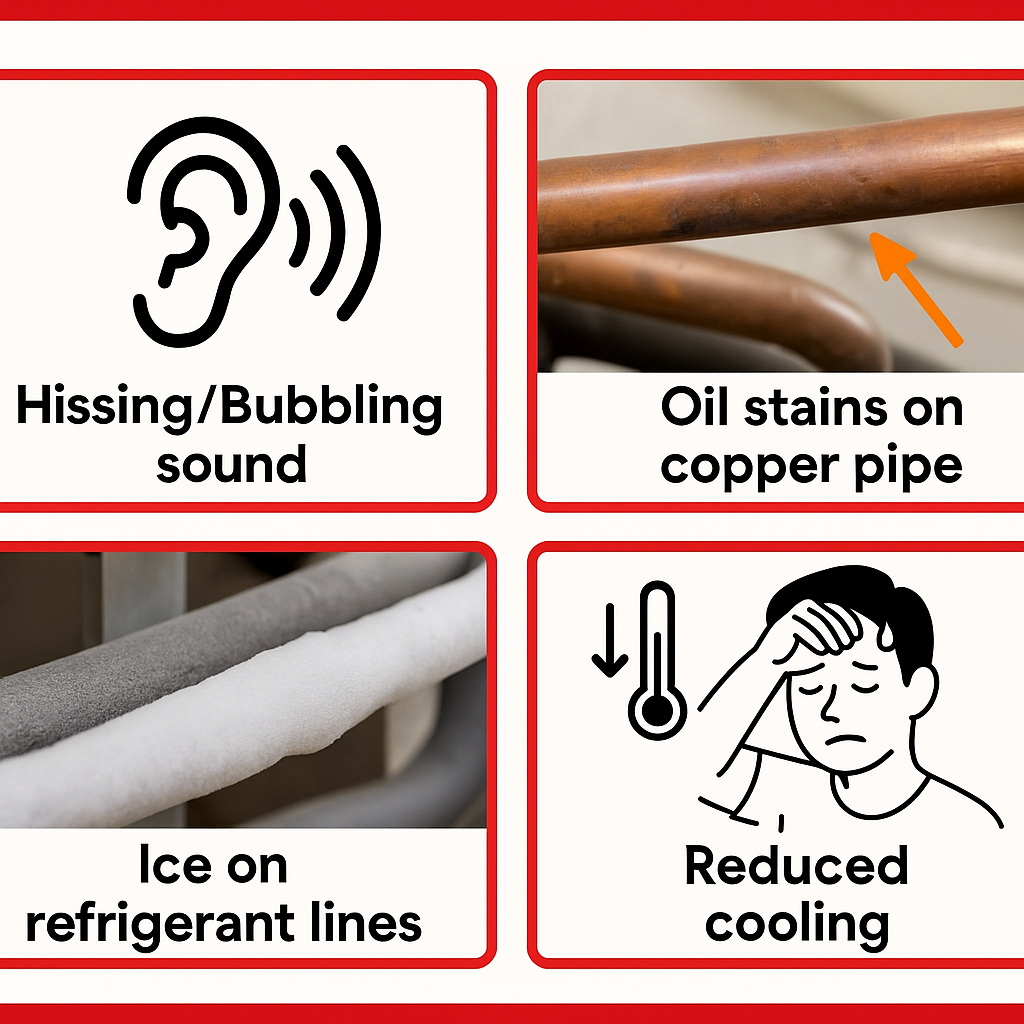
Problem
Blower fan running slow or weak (motor issue, capacitor failure)
Solution
Technician tests fan motor and capacitor. Capacitor replacement: ₹300-₹800. Fan motor replacement: ₹2,000-₹4,000. Proper airflow prevents freezing.
Problem
Blocked return air vents (furniture, curtains against indoor unit)
Solution
Move furniture, curtains at least 6 inches away from AC. Ensure clear airflow around return air grilles. Maintain proper clearance—free and immediate fix.
Problem
Dirty evaporator coils reducing heat exchange efficiency
Solution
Professional deep coil cleaning with chemical cleaner: ₹1,000-₹2,500. Annual cleaning prevents freezing. DIY: gentle water spray after defrosting (power OFF).
Problem
Thermostat set too low (16-18°C) in well-insulated small room
Solution
Set temperature to 24-26°C for comfortable, efficient cooling. Avoid running at extreme low settings overnight. Prevents overcooling and freezing.
Problem
Faulty expansion valve or metering device causing improper refrigerant flow
Solution
Technician diagnosis required with pressure gauges. Expansion valve replacement: ₹1,800-₹4,000. Critical component—professional service only.
Problem
Running AC continuously at night in closed, small bedroom
Solution
Use sleep mode or timer function. Set higher temperature (26-27°C) at night. Allow some ventilation—crack door slightly to balance airflow and prevent over-cooling.
🛠️ Step-by-Step Defrosting & Repair Process
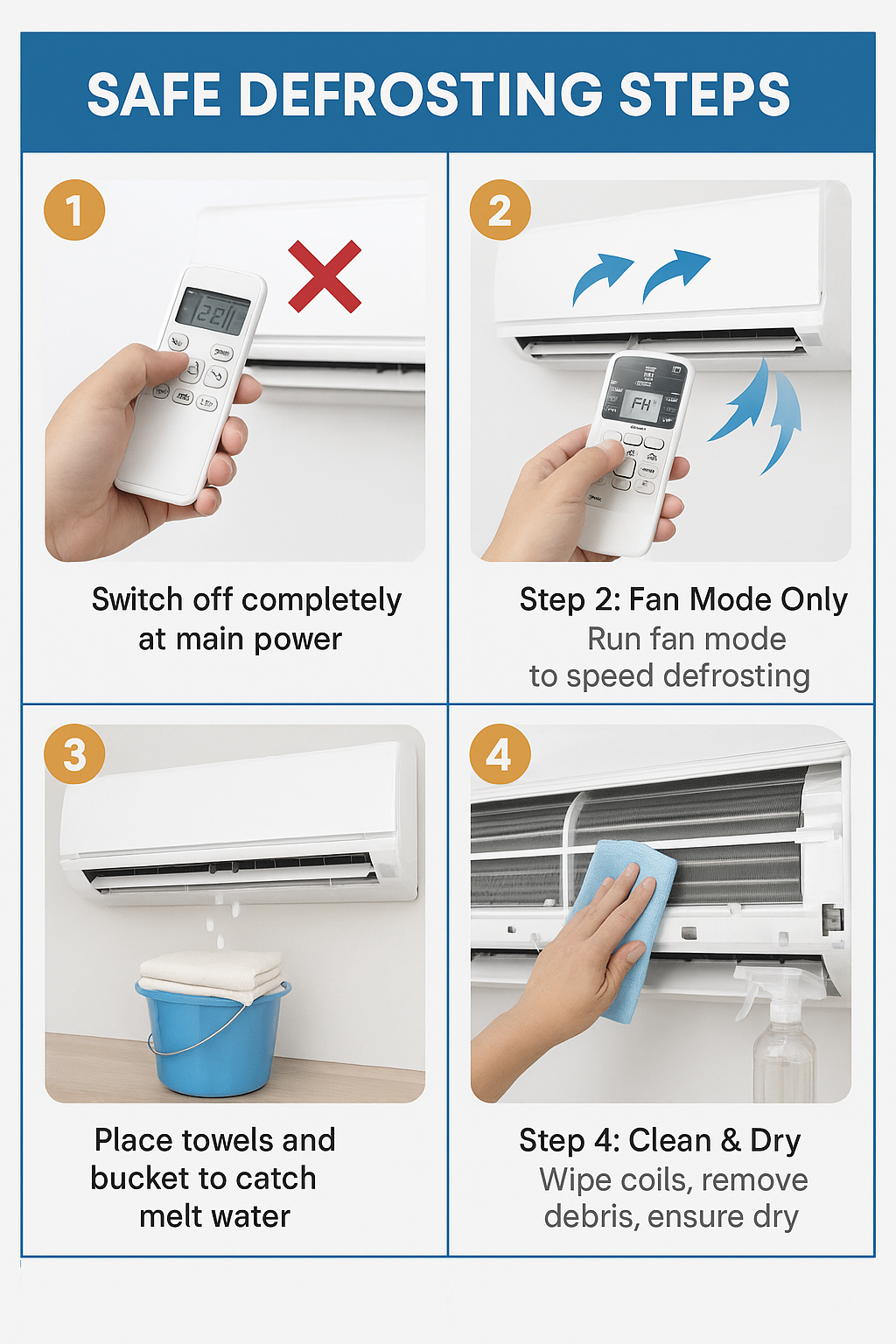
Immediate Shutdown & Preparation
• Turn OFF AC immediately—stop compressor to prevent liquid slugging damage
• Switch off circuit breaker for complete power disconnection and safety
• Place large towels or absorbent cloths under indoor unit to catch melting water
• Position bucket or container under drain outlet—ice melt creates significant water
• Open indoor unit cover/panel to expose frozen evaporator coils
• Take photo of ice location and extent for reference if technician needed
Natural Defrosting Process (Recommended)
• Allow ice to melt naturally at room temperature (2-6 hours depending on ice thickness)
• Keep AC panel open for air circulation—speeds defrosting slightly
• Check water accumulation every 30 minutes, empty containers as needed
• Light ice: 1-2 hours to defrost | Moderate ice: 3-4 hours | Heavy ice: 5-6 hours
• Monitor drain pan—may overflow if drain pipe blocked, clear immediately
• Ensure complete melting—no ice chunks remaining on coils or pipes
Clean Air Filters Thoroughly
• Remove mesh air filters from indoor unit (usually slide out or lift tabs)
• Wash filters with mild detergent and lukewarm water, scrub gently with soft brush
• Rinse thoroughly under running water until water runs clear
• Shake off excess water, air dry completely in shade (2-3 hours minimum)
• NEVER reinstall wet filters—causes mold, electrical issues, and repeat freezing
• If filters heavily damaged or torn, replace with manufacturer-approved filters
Inspect & Clean Evaporator Coils (DIY Safe Method)
• After complete defrost and with power OFF, examine evaporator coil fins
• Look for dust, debris, or coating on aluminum fins behind filter area
• Gently brush visible dust with soft brush (old toothbrush works well)
• Use spray bottle with water to rinse accessible coil sections lightly
• Wipe down with clean cloth—remove any visible dirt or buildup
• For heavy buildup: Schedule professional chemical coil cleaning (₹1,000-₹2,500)
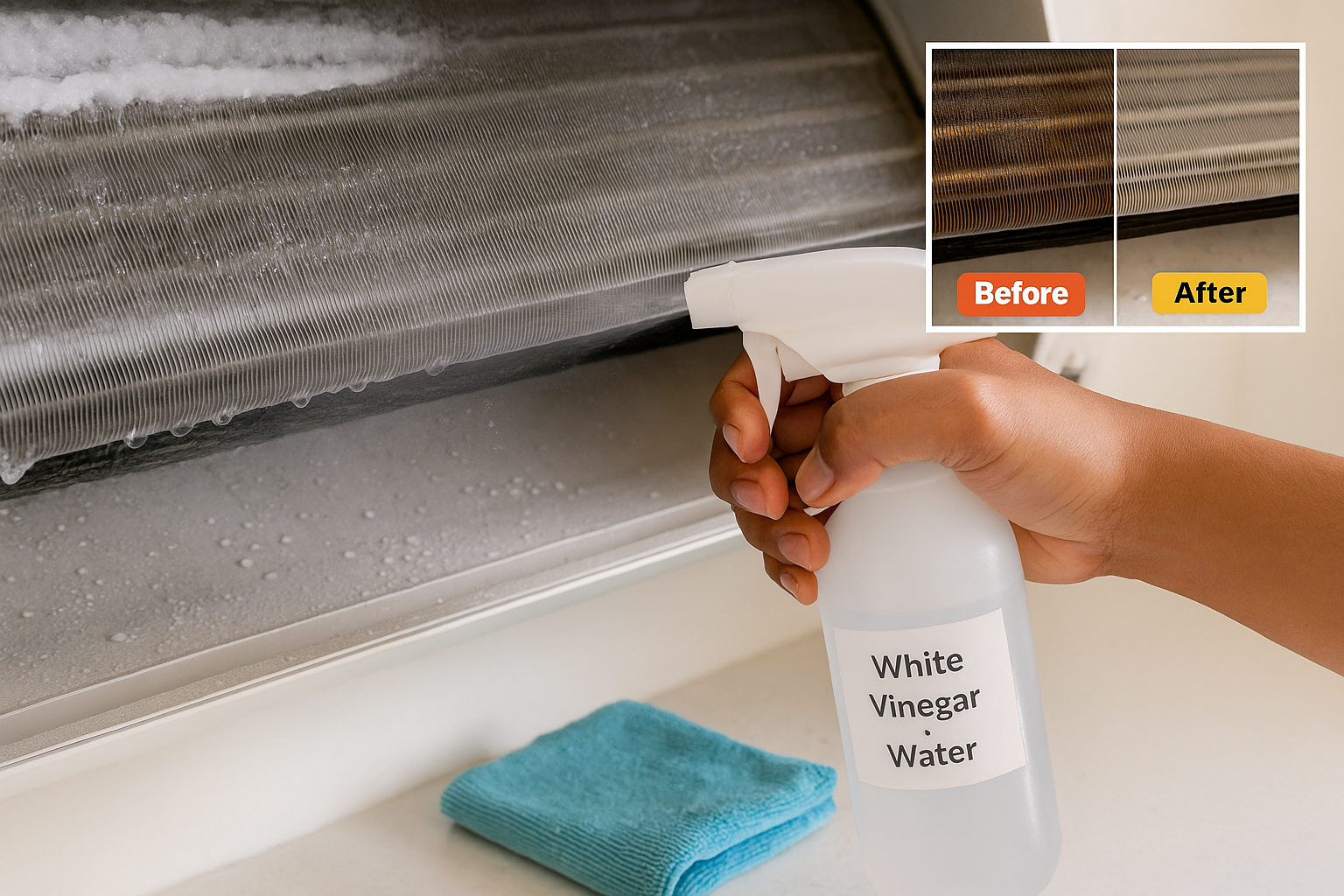
Clear Return Air Blockages
• Identify all return air vents/grilles on indoor unit (usually sides or bottom)
• Move furniture, beds, curtains at least 6 inches away from AC unit
• Remove any decorative items, wall hangings blocking air intake
• Ensure 1-2 feet clear space around entire indoor unit perimeter
• Check room layout—avoid placing large objects that create dead zones
• Proper airflow crucial—AC needs to breathe to prevent freezing
Test Blower Fan Function
• After defrosting, restore power and set AC to FAN ONLY mode (not cooling)
• Listen and feel air output—should be strong, consistent airflow
• Weak airflow indicates fan motor or capacitor issue
• Fan should sound smooth—grinding, squealing means bearing problems
• If fan weak/slow despite clean filters: Call technician for fan diagnosis
• Fan motor issues require professional repair—capacitor (₹300-₹800) or motor (₹2,000-₹4,000)
Gradual Restart & Monitoring
• Ensure AC completely dry—no moisture on coils, panels, or electrical components
• Reinstall clean, completely dry air filters securely
• Set AC to moderate temperature (24-26°C), medium fan speed
• Run in cooling mode and monitor for 30 minutes continuously
• Check copper pipes near indoor unit—should feel cool, NOT icy cold or frosted
• Feel air output temperature—should be cool (8-12°C below room temp)
• Watch for any frost formation on coils through first hour of operation
Check for Refrigerant Issues (Signs Only—Don't DIY)
Signs of low refrigerant causing freezing:
• Ice forms primarily on suction line (larger copper pipe) near indoor unit
• AC cooled poorly for days/weeks BEFORE freezing started
• Oil stains visible around copper pipe joints or connections
• Hissing or bubbling sounds from refrigerant lines
• Ice on outdoor unit coils (unusual—indicates serious refrigerant issue)
If refrigerant suspected, stop AC and call technician—no DIY solution
Optimize Temperature & Usage Settings
• Set realistic temperature: 24-26°C optimal for comfort and efficiency
• Avoid extreme low settings (16-18°C) especially in small, sealed rooms
• Use sleep mode at night—automatically adjusts temp to prevent overcooling
• Enable auto fan speed—allows AC to regulate airflow appropriately
• Don't block airflow with bedding, curtains during sleep
• For small bedrooms: Set timer to cycle off periodically (prevents overcooling)
• Consider portable fan with AC to improve circulation without lowering temp
When Professional Help Required
Call technician if ice reforms after:
• Filter cleaning and proper clearance maintained
• Temperature set reasonably (24-26°C) with good airflow
• Blower fan working normally with strong output
• Freezing recurs within hours or days of defrosting
Professional diagnosis needed for:
• Low refrigerant requiring leak detection and gas refill
• Expansion valve malfunction requiring replacement
• Blower fan motor or capacitor failure
• Evaporator coil severely fouled needing chemical cleaning
• Thermostat or sensor malfunction causing improper cycling
📞 When to Call a Professional
⚡ Refrigerant & Gas Issues
- • Ice reforms within 1-2 hours despite clean filters
- • Ice primarily on suction line (larger copper pipe)
- • Oil stains around copper pipe connections
- • Hissing or bubbling sounds from refrigerant lines
- • AC cooled poorly before freezing started
- • Ice on outdoor unit coils (serious refrigerant issue)
🔧 Mechanical & Airflow Problems
- • Blower fan running slow despite clean filters
- • Weak airflow from indoor unit vents
- • Grinding or squealing noise from blower
- • Freezing recurs after proper defrosting & maintenance
- • Evaporator coils heavily fouled, caked with debris
- • Drain pan overflowing due to blocked drain pipe
💰 Expected Repair Costs (2025 India)
Blower Fan Capacitor: ₹300-₹800
Evaporator Coil Chemical Clean: ₹1,000-₹2,500
Expansion Valve Replace: ₹1,800-₹4,000
Drain Line Cleaning/Repair: ₹300-₹1,000
Complete AC Service: ₹800-₹2,000
Diagnostic Visit: ₹500-₹1,000
🔍 Questions to Ask Technician
- • What is exact root cause of freezing? (Airflow vs. refrigerant vs. mechanical?)
- • Can you show me the problem component? (Dirty coils, weak fan, leak location)
- • What are current refrigerant pressures? (Should be 65-70 PSI for most ACs)
- • If refrigerant low, where is the leak? (Leak must be repaired before refilling)
- • Is this a chronic issue or one-time fix? (Will freezing recur?)
- • What preventive maintenance prevents repeat freezing? (Filter schedule, service interval)
- • Is warranty still valid? (New ACs—insist on authorized service only)
📊 Freezing Diagnosis Decision Tree
| Symptom Pattern | Most Likely Cause | Solution | DIY? |
|---|---|---|---|
| Ice on coils, filters very dirty, airflow weak | Clogged air filters | Defrost, clean filters thoroughly, maintain 2-week cleaning | ✓ Yes |
| Ice on suction pipe, oil stains on connections | Low refrigerant (leak) | Professional leak detection, repair, vacuum, gas refill | ✗ No |
| Furniture/curtains against AC, poor circulation | Blocked return air | Clear 6-inch space around AC, remove obstructions | ✓ Yes |
| Weak air output, fan sounds slow/struggling | Blower fan/capacitor failure | Technician tests fan motor, replaces capacitor or motor | ✗ No |
| Freezing at night in small room, temp set 16-18°C | Overcooling in sealed room | Set 24-26°C, use sleep mode, allow slight ventilation | ✓ Yes |
| Coils heavily caked with dust/debris, filters clean | Dirty evaporator coils | Professional chemical coil cleaning, annual maintenance | ⚠ Pro |
| Ice reforms quickly after defrost, all else normal | Expansion valve fault | Technician diagnosis with gauges, valve replacement | ✗ No |
| New AC freezing from day one | Installation issue (air in lines, low gas) | Call installer/dealer immediately under warranty | ✗ No |
🛡️ Preventive Care & Freezing Prevention
Every 2 Weeks
Clean air filters thoroughly, check for ice on visible pipes, ensure clear airflow space, verify drain flow
Every 6 Months (Pre-Summer/Winter)
Professional coil cleaning, refrigerant pressure check, blower fan inspection, full system service
Freezing Warning Signs
Frost on copper pipes, weak airflow despite clean filters, cooling decline, water leaks, unusual sounds
💡 Essential Freezing Prevention Tips:
- • Regular filter cleaning: #1 prevention—clean every 2 weeks in dusty areas, monthly minimum. 70% of freezing prevented.
- • Maintain clearance: 6-inch minimum space around entire AC unit. Never block return air vents with furniture/curtains.
- • Realistic temperature settings: 24-26°C optimal. Avoid extreme low settings (16-18°C) especially in small rooms overnight.
- • Use sleep/timer modes: Prevents overcooling during night. AC automatically adjusts temperature or cycles off.
- • Annual professional service: Chemical coil cleaning, refrigerant check, blower inspection prevents chronic freezing.
- • Monitor early warning signs: Light frost on pipes = immediate filter cleaning needed. Don't wait for heavy ice.
- • Proper room ventilation: Small sealed rooms prone to freezing. Allow slight air exchange (crack door) during continuous operation.
- • Address refrigerant leaks promptly: Low gas causes freezing AND compressor damage. Fix leaks immediately when detected.
📋 Freezing Prevention Checklist
✓ Visual check for frost on visible pipes
✓ Ensure proper temperature setting (24-26°C)
✓ Verify strong airflow from vents
✓ Maintain clear space around AC
✓ Use sleep mode for overnight operation
✓ Thoroughly clean air filters
✓ Check drain pan for water flow
✓ Inspect copper pipes for frost/oil
✓ Test blower fan performance
✓ Schedule service if issues noticed
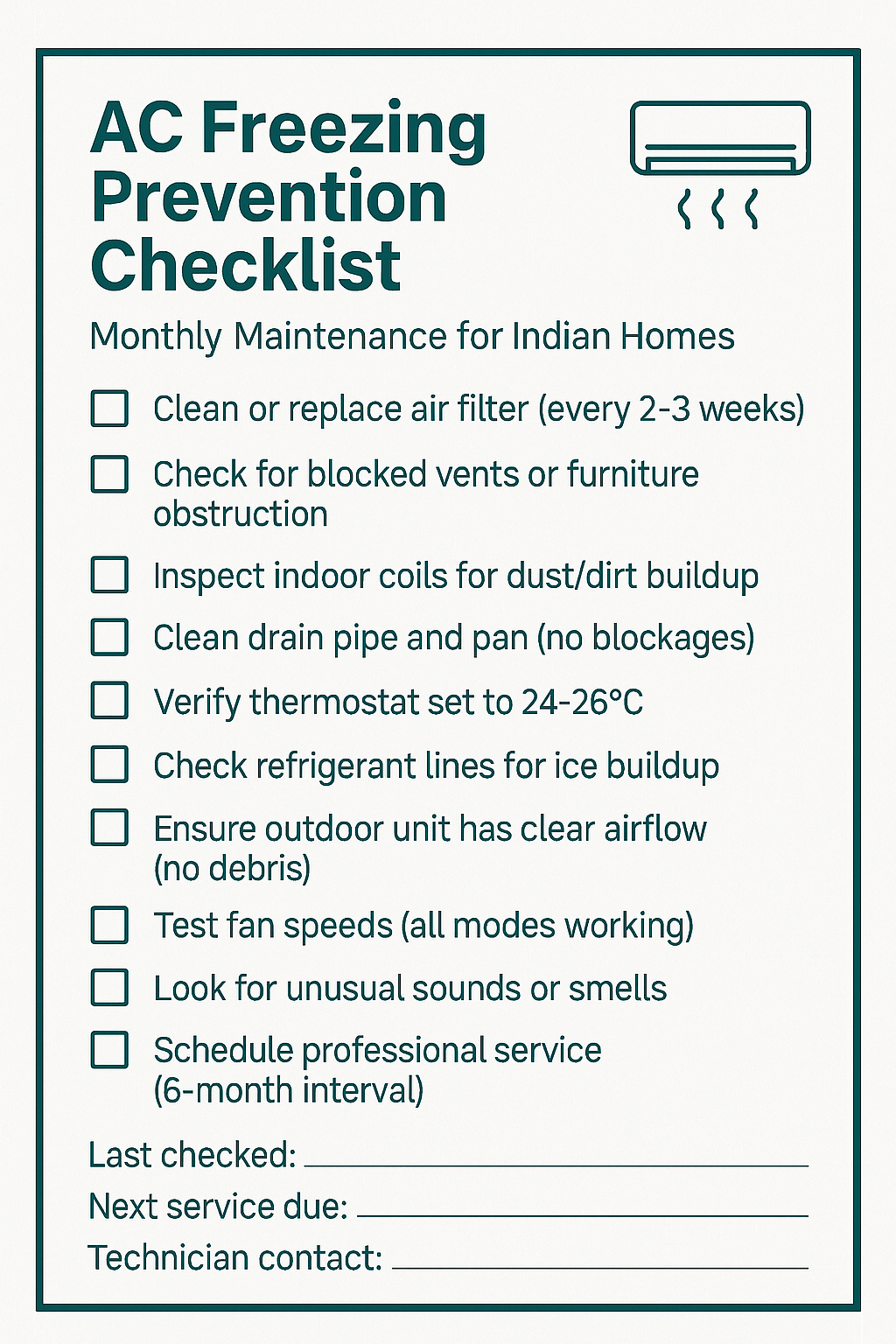
❓ Frequently Asked Questions
Q1: How long does it take to defrost a frozen AC? Can I speed it up?
Quick Answer: 2-6 hours naturally. Light frost: 1-2 hours | Moderate: 3-4 hours | Heavy: 5-6 hours. Use room fan (not heat) to speed up safely.
Natural defrosting time depends on ice thickness: Light frost (1-2 hours), Moderate ice (3-4 hours), Heavy ice buildup (5-6 hours). Speed up by pointing room fan toward coils (NOT hairdryer/heat gun—damages fins). Never use hot water, scraping, or chipping—permanently damages delicate aluminum fins. Keep power OFF during entire defrost, monitor water drainage carefully.
Q2: AC freezes up every night when running continuously. What's wrong?
Quick Answer: Over-cooling in small sealed rooms at 16-18°C. Set to 25-26°C, use sleep mode, allow slight ventilation.
Common in small bedrooms with AC set too low (16-18°C) and doors/windows sealed. Over-cooling in sealed space causes temperature drop below freezing point at evaporator. Solutions: (1) Set temperature 25-26°C, (2) Use sleep mode—automatically increases temp gradually, (3) Crack door slightly for air exchange, (4) Use timer to cycle AC off periodically, (5) Ensure filters clean and airflow unrestricted. Small rooms need temperature moderation. Check our AC buying guide for proper tonnage selection.
Q3: Ice forming only on the large copper pipe (suction line). Is this normal?
Quick Answer: NO—indicates LOW REFRIGERANT. Call technician immediately. Cost: ₹2,500-₹6,000 for leak repair and gas refill.
NO—ice on suction line (larger, insulated copper pipe) indicates LOW REFRIGERANT issue. With insufficient gas, evaporator over-cools causing ice to travel down suction line. Often accompanied by: oil stains at connections, poor cooling before freezing, hissing sounds. This requires professional leak detection, repair, and gas refill (₹2,500-₹6,000). Clean filters won't fix refrigerant issue—call technician immediately. Continuing to run damages compressor.
Q4: Cleaned filters thoroughly but AC still freezes within hours. What next?
Quick Answer: Call technician—likely low refrigerant, weak blower fan, or expansion valve issue. DIY options exhausted.
If freezing persists despite clean filters and proper clearance, underlying mechanical issue exists: (1) Low refrigerant requiring professional gas refill, (2) Blower fan motor weak/failing—reduced airflow, (3) Evaporator coils severely fouled—needs chemical cleaning, (4) Expansion valve malfunction, (5) Faulty thermostat causing improper cycling. DIY solutions exhausted—call technician for diagnosis with pressure gauges and multimeter. Continuing to defrost/restart without fixing root cause damages compressor. See AC not cooling guide for related issues.
Q5: Can I run AC while ice is melting to speed up defrosting?
Quick Answer: ABSOLUTELY NOT—causes liquid slugging, destroys compressor. Cost: ₹15,000-₹25,000 replacement. Always turn OFF completely.
ABSOLUTELY NOT—running AC with frozen evaporator is most dangerous thing you can do. Ice blocks airflow causing liquid refrigerant to return to compressor (liquid slugging). Compressors designed for gas compression, NOT liquid—causes immediate mechanical damage, cracked pistons, valve failure. Compressor replacement: ₹15,000-₹25,000. ALWAYS turn AC completely OFF at circuit breaker when ice present. Let defrost naturally with power OFF. Only restart when completely dry and root cause addressed.
Q6: Ice on outdoor unit coils—is this different from indoor unit freezing?
Quick Answer: YES—SERIOUS refrigerant problem. Outdoor unit should NEVER freeze. Turn OFF immediately, call technician urgently.
YES—ice on outdoor (condenser) unit is SERIOUS refrigerant problem, not typical airflow issue. Indicates: severe refrigerant leak, grossly overcharged system, or failed metering device. Outdoor unit should NEVER freeze during normal operation—it expels heat, stays warm. If outdoor unit iced over: (1) Turn OFF immediately, (2) Call professional technician urgently, (3) Do not attempt any DIY fixes, (4) Likely requires complete refrigerant system service. This is not simple filter cleaning fix.
Q7: After defrosting, how do I prevent freezing from happening again?
Quick Answer: Clean filters every 2 weeks, set temp 24-26°C, maintain 6-inch clearance, annual professional service.
Prevention strategy depends on root cause: (1) If dirty filters caused it: Clean filters every 2 weeks religiously, (2) If overcooling caused it: Set temp 24-26°C, use sleep mode, avoid extreme low settings, (3) If blocked airflow: Maintain 6-inch clearance, remove obstructions, (4) Ensure blower fan working strongly, (5) Schedule annual professional coil cleaning and refrigerant check, (6) Monitor for early frost—address immediately before heavy ice forms. Most freezing preventable with regular filter maintenance and proper settings.
Q8: Water dripping from indoor unit during defrost—is this normal? How much water?
Quick Answer: YES—completely normal. Expect 2-5 liters of water. Place towels and bucket under unit, check drain pan every 30 minutes.
YES—completely normal during defrosting. Heavy ice buildup creates significant water when melting—expect 2-5 liters depending on ice extent. Preparation critical: (1) Place large towels/cloths under unit, (2) Position bucket under drain outlet, (3) Check drain pan every 30 minutes—may overflow if drain pipe blocked, (4) If drain blocked, water overflows pan edge causing damage. Normal drain: water flows smoothly through drain pipe. Blocked drain: water backs up in pan then overflows—clear drain immediately.
Q9: New AC freezing from installation day. Is this covered under warranty?
Quick Answer: YES—warranty covers installation defects. Call dealer immediately. Demand pressure check, vacuum test, proper refrigerant charge.
YES—new AC should NEVER freeze if installed properly. Installation issues causing freezing: (1) Insufficient refrigerant charge, (2) Air in refrigerant lines (improper vacuuming), (3) Kinked copper pipes restricting flow, (4) Drain line improperly installed. Call dealer/installer IMMEDIATELY under warranty—don't accept "wait and see" excuse. Demand: (1) Complete system pressure check, (2) Vacuum test for leaks, (3) Proper refrigerant charging, (4) Written confirmation of fix. Installation defects covered under warranty—insist on proper correction.
Q10: Does freezing damage the AC permanently? Should I worry about compressor?
Quick Answer: Occasional (1-2 times)—no damage if fixed. CHRONIC freezing—serious compressor damage. Fix early: ₹2,000-₹6,000 vs. ₹15,000-₹25,000 replacement.
Occasional freezing (1-2 times) if addressed properly—no permanent damage. CHRONIC freezing (weekly/monthly recurrence) causes serious compressor damage from: (1) Liquid refrigerant return (liquid slugging)—cracks compressor internals, (2) Oil dilution reducing lubrication—increases wear, (3) Thermal stress from freeze-thaw cycles. If freezing recurs despite fixes: STOP using AC, get professional diagnosis immediately. Ignoring chronic freezing leads to compressor failure (₹15,000-₹25,000 replacement) vs. fixing root cause early (₹2,000-₹6,000). Address freezing promptly—prevents expensive damage.
⚠️ Disclaimer: This troubleshooting guide is for informational and educational purposes only. AC freezing involving refrigerant issues, compressor problems, or electrical components requires certified professional technicians. Never run AC with frozen coils—causes severe compressor damage. Never attempt refrigerant work yourself—illegal and dangerous. Never chip or scrape ice—damages delicate fins. If unsure about any procedure, or if freezing recurs after DIY attempts, contact authorized service centers immediately. Improper repairs can cause equipment damage, personal injury, environmental harm, or void warranty. When in doubt, call a professional.
📚 Related Troubleshooting Guides & Resources
AC Not Cooling Properly?
Fix compressor, gas leak, and filter issues
AC Not Turning On?
Diagnose power, remote, and PCB problems
Complete AC Buying Guide
Choose the right tonnage, BEE rating, and features for Indian homes
Air Filter Cleaning Guide
Learn proper filter maintenance techniques
BEE Star Rating Explained
Understand energy efficiency ratings for ACs
All Troubleshooting Guides
Browse complete troubleshooting library
Important Safety Reminder
If you're not comfortable with any step, or if the problem persists after trying these solutions, please contact a qualified technician. Safety should always be your first priority when dealing with electrical appliances.
You May Also Like
Discover more helpful guides and reviews to make informed decisions
AMOLED vs IPS LCD 2025: Which Phone Display is Better? (Eye Comfort Test)
AMOLED: infinite contrast & Always-On Display vs IPS LCD: no PWM flicker & no burn-in. Complete comparison for ₹15k-₹35k phones. PWM sensitivity test, battery life, brightness, real-world usage guide.
Autoclean vs Filter Kitchen Chimney: Complete 5-Year Cost Analysis 2025
Complete comparison guide for choosing between autoclean (filterless) and filter-based kitchen chimneys for Indian cooking. Compare costs, maintenance, performance and 5-year total ownership cost.
Front Load vs Top Load Washing Machine 2025: Which Saves More? (Real Data)
Front load saves ₹904/year on water but top load washes 40% faster. Complete comparison with actual running costs, fabric care, maintenance for Indian homes. Find which type suits your family size & budget.
Inverter vs Non-Inverter AC 2025: Which Saves More Money? (₹ Calculator)
Complete comparison: Inverter AC saves ₹5,000/year on bills for 8hr/day use vs non-inverter. Temperature stability, noise, efficiency & real electricity cost breakdown for Indian summers 2025.
Instant vs Storage Geyser 2025: Which Saves More Electricity? (Power Calculator)
Storage geyser (2kW) vs instant (3-6kW): Storage better for Indian homes with limited electrical capacity. Complete comparison of power consumption, winter performance, space needs & costs for bathrooms.
Latex vs Memory Foam Mattress 2025: Which Stays Cooler? (Temperature Test)
Latex sleeps 3-4°C cooler than memory foam in Indian summers. Complete comparison: durability (latex 12+ years vs foam 6-8), price, support, comfort. Which mattress for hot sleepers?
Microfiber vs Memory Foam Pillow 2025: Which for Neck Pain? (Support Test)
Memory foam gives consistent neck support vs microfiber loses shape. Compare: washability (micro wins), cooling (micro cooler), price (₹500-₹2k vs ₹1.5k-₹5k), durability, sleep positions.
Oil-filled vs Fan Heater 2025: Which for Delhi/Punjab Winters? (Cost & Silence Test)
Oil-filled heaters save ₹500-₹1,200/winter through heat retention vs fan heaters (quick 5-min warmup). Compare silence (0 dB vs 50 dB), safety for kids, running costs @₹8/kWh for Delhi-NCR, Punjab, Haryana winters.
Vertical vs Horizontal Geyser 2025: Which Gives Better Hot Water? (Space Guide)
Vertical geysers give 15-20% more consistent hot water vs horizontal. Compare space needs (18"×14" vs 24"×10"), installation cost (₹500-800 difference), thermal efficiency & real Indian bathroom fits.
Need to Buy a New Air Conditioner?
Check out our comprehensive buying guides and reviews